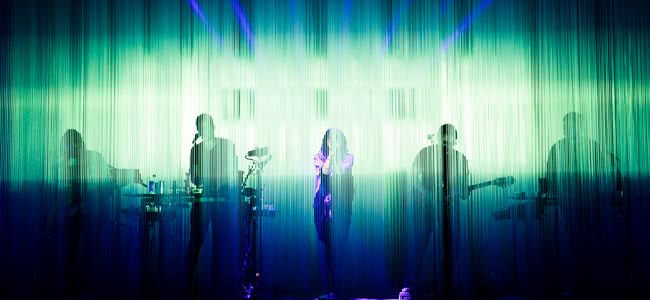It’s not often that you’d be happy to go see a band play behind a screen, but that’s exactly what How To Destroy Angels – Trent Reznor’s side project with his wife Mariqueen Maandig – are doing.
When said obstructive screen is operated by the likes of Rob Sheridan, the art director for How To Destroy Angels, the light show itself is as much an instrument as those that craft the music.
Currently in the midst of a 12-show tour in their native USA, Reznor, Maandig, and long-time collaborator Atticus Ross are joined on stage by Sheridan, who is in control of the highly impressive accompanying light show.
As reported on Wired.com, the 33 year old self-proclaimed “artist/designer/photographer/nerd” works a 16-foot tall curtain of 14-inch surgical tubing and a huge projector to create “a shimmering, three-dimensional cube of light effects”. The whole dazzling set-up operated by a Livid MIDI controller and program called Lemur on an iPad Mini.
The translucent screen is designed to adapt throughout the show, so that at times you may see “the band’s silhouettes, faces, or nothing at all.” Combined with the images on the projector screen, Wired described it as “creating a three-dimensional feel, with the band almost floating in between.”
After premiering their luminescent extravaganza at Coachella 2013 to a receptive – to say the least – crowd (Rolling Stone called their set “the most transportive of the day”), the band decided that it was worth including it on subsequent tours.
In a YouTube video explaining their performance, Reznor says “we’ve essentially spent over a year experimenting with different materials to try to present this in a way that felt cool to us, and it was a lot of effort for just a few shows.” “We’ve essentially spent over a year experimenting with different materials to try to present this in a way that felt cool to us, and it was a lot of effort for just a few shows.” – Trent Reznor
Atticus Ross says they’re hoping audiences will “get lost” at their shows thanks to the “beautiful setting” that Sheridan creates.
They’re hardly the first band to experiment with incorporating a visually resplendid light show into their performance (electronic dance acts like Daft Punk and Amon Tobin have been known for their awe-inspiring projections when they play live) but Sheridan debates that the experience is far more enriching when coupled with HTDA’s style of music.
“We also have a distinct advantage over that type of stuff. We have actual musicians on stage playing real instruments, and a lead singer who carries a lot of emotion and personality and voice,” says Sheridan.
As they continue their American tour, Reznor has openly proclaimed, “there’s been a high level of anxiety but I can’t wait to show this to the world.”
The HTDA light show is just one of many things that he’ll be showing the world, as Reznor is fast-becoming one of the busiest men in music. Having kept busy writing film scores for David Fincher’s The Social Network and The Girl With The Dragon Tattoo, as well as getting involved with the blockbuster video game franchise, Call Of Duty, Reznor is returning to his better-known band, Nine Inch Nails.
Despite breaking up in 2009, NIN are currently in the middle of a massive comeback, featuring on the bills of Fuji Rock and Lollapalooza, as well as many other festivals around the world, with a newly-revised and “refocussed” Nine Inch Nails lineup.
The 2013 live ranks includes Reznor, regular NIN members Alessandro Cortini and Ilan Rubin, along with Eric Avery (Jane’s Addiction), Josh Eustis (Telefon Tel Aviv), and King Crimson alumni Adrian Belew.
Speaking about the forthcoming world tour, Reznor said “the intention is to reconstruct songs based on this new instrumentation and only play songs we as a band feel good about.”
“With Nine Inch Nails last time, I felt that I’d explored that kind of bludgeoning rock thing in a lot of different ways, like I’d done everything I could do with that format,” he added.
As for the possibility of new material – which Reznor hinted at late last year – being aired on tour, the NIN leader was more frank: “There isn’t any new material to play except from a couple of tracks Adrian [Belew] and I started experimenting on that were intended to go on a greatest hits record. We decided to push that back to 2014, and there’s no new record scheduled at this point.”
To get NIN fans back in the mood, Reznor has been drip-feeding old material from the archives on a newly-created Tumblr page. A veritable treasure trove of rare photos, images, artwork, and videos from the group’s long history has been made available to the public.
Best of all is the rarely seen 75-minute tour documentary about the group’s Self Destruct Tour, which began in 1994 and ran until mid-1996 across 8 massive legs to promote the landmark NIN opus, The Downward Spiral. Check it out here.




































